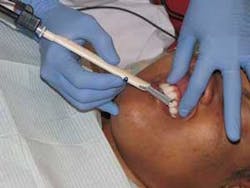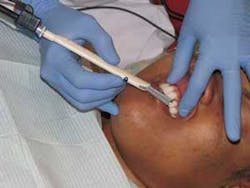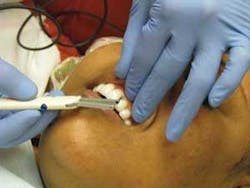ROI on probing
How to make automated probing a sound investment
by Kim Stevens, RDH
In the last 30-plus years, dentistry has evolved through so many changes after so many opinions to the same question we should never cease asking. How can we do this better for patients and clinicians and make a profit? Well, not just for profit's sake, but especially for the patients' benefit. With the currently known systemic links to oral health, what is a standard of care that has consistent results for patients and clinicians alike that also produces a profit, creating a win-win result for everyone?
There are so many opinions, as well as technologies. Keeping up — as well as implementing them — can be completely overwhelming. We are still facing the same questions that we were asking ourselves 20 years ago. We are trying to get better and faster to get great results for the patient. And don't forget, it all needs to be “painless.”
There is great news! We are having success. With new restorative materials, lasers, implant technology, and diagnostic equipment, we have made huge strides in giving our patients successful and more pain-free dentistry that aids in helping them be healthier head to toe, and we are making a profit too.
Clinicians have been getting good results with many different procedures, whether it is amalgam vs. tooth-colored restorations with adhesive dentistry, removable dentures, and bonded bridges vs. implants, brackets vs. Invisalign for ortho, or cold knife procedures for periodontal procedures vs. lasers, trays, and scaling and root planing with soft tissue management.
This is where so many opinions can make your head swim. It's kind of like choosing a religion. Just pick the one that you are personally most comfortable with and go with that one. In dentistry, that is not always what is best for the patient.
But it is the best we can do without spending all of our time and money learning and buying everything, using our patients as guinea pigs to find out what the fastest, most painless, and profitable treatments are that help our patients to be happier and healthier and make sure dental offices make a profit.
About six years ago, I did find a diagnostic tool that enabled me to help provide my patients a way to understand and participate in making the decisions needed to help them be healthier and happier when it comes to periodontal procedures. It also helps create that win-win goal for every dental office, even if there is no availability of hygienists. It is consistent, has repeatable accuracy, and it is painless. It covers legalities for recordkeeping and insurance purposes, saves time, and it greatly increases profits. It is called the Florida Probe.
What should be the standard of care?
I graduated from dental hygiene school 30 years ago with the idea driven into me that pocket probing is what we use to determine the presence and extent of periodontal disease. We have added bacterial analysis, but probing depths are still the standard. While the standard of care on how often we should probe has not been set in concrete, with the great increase in litigation with periodontal disease, making sure a complete and accurately documented periodontal evaluation is done every 12 months should certainly be the recommended standard of care. With periodontal maintenance patients, every six months would be best, and medically compromised and high risk patients would also certainly fall into this category, given the systemic links to oral health.
The first objection to this standard is the time factor. It is not just the time it takes to probe, but also to document depths, recession, mobility, furcation, risk assessment, explaining to patient about the information and what it means, and treatment options. With the Florida Probe, a painless comprehensive record can be obtained in the same time it takes to probe manually with someone else doing the recording. The instrument, however, is used by a single practitioner. When you are finished, the patient fully understands what it all means and can make a decision on any treatment needed. I know this can be donebecause I have been accomplishing this for the last six years in two offices.
The patients' comprehension of periodontal disease is enhanced, and they can make decisions based on this knowledge, as well as deciding about spending the money on treatment. You can only spin periodontal disease so many ways. With all of the personality types ranging from the uneducated to the analytical, I greatly welcomed this advantage.
In addition, there is no more going over “how is it I have this disease and didn't know it” many different times by both the dental hygienist and the doctor. It is an end to that endless feeling that you are just repeating yourself over and over again.
I have experienced other computerized probing instruments. Often, they respond with the wrong number or with something completely off track, or the records are not comprehensive enough and difficult to read — not at all patient friendly. I send the same Florida Probe form home with my patients as I do to the insurance companies, and the form is easy to read for both parties.
The increase in dental hygiene production
My production increased because of the time saved with the educational tools and being able to be so comprehensive and thorough in documentation — without calling in someone to help record it all — puts a smile on everyone's face at the office. Production climbed quickly to $330,000 to $350,000 every year.
My patients accepted the periodontal treatments whether it was expensive laser treatments or four quadrants of scaling and root planing. The patients completely understood periodontal disease and the extent of it for them personally. They keep track of what they heard and have surprised me many times with the accuracy of remembering pocket depths on particular teeth and noticing the improvement each time I probed them. Hours of educating, explaining, and documenting by both me and the doctor turned into minutes.
So what I now have is a single-user, painless probing instrument that gives the same consistent results within two tenths of a millimeter, regardless of who the trained clinician is, and produces an easy to read document.
Both doctors returned from a weekend seminar. One bought a laser, and the other purchased a periodontal tray method. They announced to me that they wanted an ROI (return on investment) from the new purchases and that it was up to me to make that happen.
I accomplished it speedily for both products with the Florida Probe as an adjunctive tool, and my patients were pleased and excited with the understanding and knowledge gained by it.
Over the years, I have personally experienced the evolution of all of the technologies available when it comes to periodontal diagnostic tools and treatments. None of the diagnostic tools for probing compare to the completeness and ease of use that I received from the Florida Probe.
While specific training is absolutely necessary, once the comfort zone is accomplished, everyone benefits with this instrument. The probe speaks many languages and along with myself, has very happy users all over the world. Check out the Web site www.floridaprobe.com.
About the author
Kim Stevens, RDH, has been a practicing hygienist for over 32 years. She has experience in all aspects of clinical hygiene and with both the use and training of lasers in periodontal therapy, as well as the different applications of the most up-to-date tools in computerized dentistry. The author has an professional affiliation with Florida Probe.


